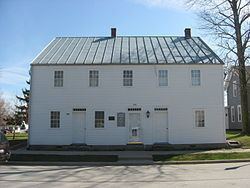Country United States FIPS code 39-54194 Elevation 288 m Zip code 45869 Local time Saturday 1:40 AM | Time zone Eastern (EST) (UTC-5) GNIS feature ID 1065111 Area 5.57 km² Population 2,983 (2013) Area code 419 | |
 | ||
Weather 16°C, Wind S at 16 km/h, 63% Humidity | ||
2016 bremenfest new bremen ohio usa parade mud volleyball chili
New Bremen (/ˈbriːmʌn/) is a village in Auglaize County, Ohio, United States. The population was 2,978 at the 2010 census. It is included in the Wapakoneta, Ohio Micropolitan Statistical Area.
Contents
- 2016 bremenfest new bremen ohio usa parade mud volleyball chili
- Map of New Bremen OH USA
- Downtown new bremen ohio lock one aerial
- History
- Schools
- Geography
- 2010 census
- 2000 census
- Notable people
- References
Map of New Bremen, OH, USA
The village was founded by German immigrants in 1832 and is named after Bremen. It is home to the Bicycle Museum of America. New Bremen is also the world headquarters of Crown Equipment Corporation.
Downtown new bremen ohio lock one aerial
History
The town was first a farming community started by Bavarians and Hanoverians, following a route from Bremen, Germany to America, through West Virginia and along the Ohio River to Cincinnati. Once Cincinnati was reached the founders formed a group called the City of Bremen Society, which drew up a charter among its 33 members. This charter authorized the purchase of 80 acres of Ohio land to build a town. This land was first established as a farming community in 1832 and by 1833 the plat of Bremen was recorded with 102 shares of land to be given away by lottery. As the town itself was established, migration to the town had been stunted by lack of usable markets, and malaria. This all would change with the completion of the Miami and Erie Canal. There were so few in the town that subcontractors had to rely of "jiggers" or 2oz bottles of whiskey to attract workers. The Canal was soon finished and opened. When opened, the Canal brought new markets to New Bremen, giving value to agricultural products that before the canal had little cash value. The town became busy place very quickly, with hundreds of freight boats moving few frequently, along with dozens of passengers boats, filled with people making the trip from Cincinnati. The locks from the Canal have been restored along with the addition of a lockkeepers house and can be seen in New Bremen's downtown area.
Schools
The New Bremen Local Schools system consists of a high school, middle school, and elementary school.
Geography
New Bremen is located at 40°26′11″N 84°22′46″W (40.436301, -84.379542).
According to the United States Census Bureau, the village has a total area of 2.15 square miles (5.57 km2), all land.
2010 census
As of the census of 2010, there were 2,978 people, 1,145 households, and 841 families residing in the village. The population density was 1,385.1 inhabitants per square mile (534.8/km2). There were 1,266 housing units at an average density of 588.8 per square mile (227.3/km2). The racial makeup of the village was 97.8% White, 0.1% African American, 0.1% Native American, 0.5% Asian, 0.4% from other races, and 1.0% from two or more races. Hispanic or Latino of any race were 1.2% of the population.
There were 1,145 households of which 35.9% had children under the age of 18 living with them, 65.3% were married couples living together, 5.4% had a female householder with no husband present, 2.7% had a male householder with no wife present, and 26.6% were non-families. 24.5% of all households were made up of individuals and 8.2% had someone living alone who was 65 years of age or older. The average household size was 2.60 and the average family size was 3.12.
The median age in the village was 38.2 years. 27.8% of residents were under the age of 18; 6.4% were between the ages of 18 and 24; 26.4% were from 25 to 44; 27.4% were from 45 to 64; and 12% were 65 years of age or older. The gender makeup of the village was 49.8% male and 50.2% female.
2000 census
As of the census of 2000, there were 2,909 people, 1,073 households, and 792 families residing in the village. The population density was 1,410.5 people per square mile (545.2/km²). There were 1,131 housing units at an average density of 548.4 per square mile (212.0/km²). The racial makeup of the village was 98.28% White, 0.03% African American, 0.38% Native American, 0.52% Asian, 0.14% from other races, and 0.65% from two or more races. Hispanic or Latino of any race were 0.31% of the population.
There were 1,073 households out of which 40.4% had children under the age of 18 living with them, 64.6% were married couples living together, 6.6% had a female householder with no husband present, and 26.1% were non-families. 24.4% of all households were made up of individuals and 11.1% had someone living alone who was 65 years of age or older. The average household size was 2.71 and the average family size was 3.26.
In the village, the population was spread out with 31.6% under the age of 18, 6.5% from 18 to 24, 30.4% from 25 to 44, 19.7% from 45 to 64, and 11.8% who were 65 years of age or older. The median age was 34 years. For every 100 females there were 96.7 males. For every 100 females age 18 and over, there were 95.0 males.
The median income for a household in the village was $51,643, and the median income for a family was $61,011. Males had a median income of $37,324 versus $24,979 for females. The per capita income for the village was $20,401. About 0.8% of families and 1.4% of the population were below the poverty line, including none of those under age 18 and 3.1% of those age 65 or over.
